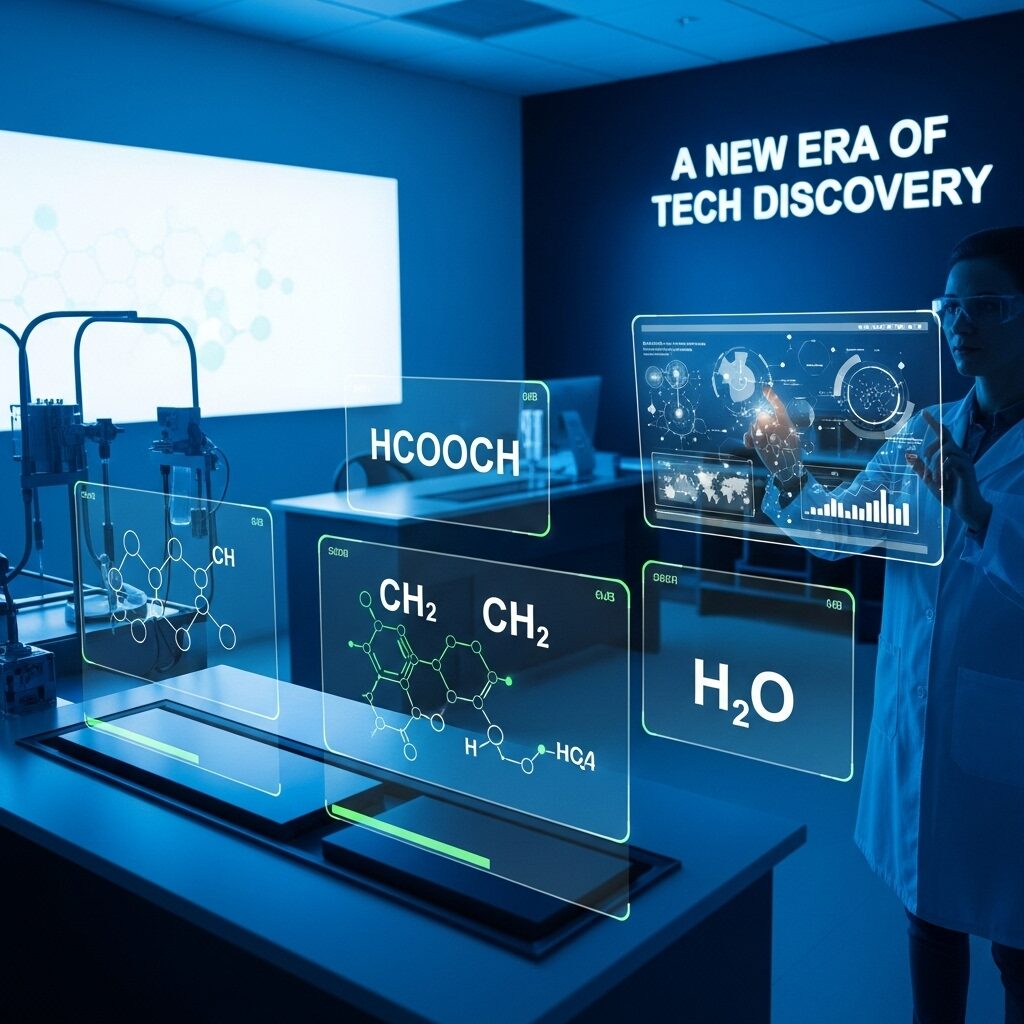Science’s secret language helps technology grow, and formulas like HCOOCH CH2 H2O do more than merely show chemistry—they inspire new ideas. This chemical shorthand leads to new discoveries that will power the technologies of the future, from research into green energy to the development of nanotechnology.This blog will talk about how HCOOCH CH2 H2O links science and technology, why it matters for innovators, and how tech blogs can make hard science easier for regular people to understand.
Chemical formulas often seem far away, like they belong to scientists in clean labs. But what if one formula could tell us the tale behind the most intriguing new inventions? HCOOCH CH2 H2O isn’t a single, naturally occurring chemical, but its parts formates, polymers, and water are what make the world go round. This isn’t just a bunch of letters and numbers it’s a plan for new ideas.
Chemistry as the Language of Tomorrow’s Technology
Chemistry is the language of technology because it provides the basis for everything from the renewable energy grids that power our cities to the cutting-edge medications that save lives. It is important for technologists, innovators, students, and anybody else who is interested in the future to understand this link. This article breaks down the formula HCOOCH CH2 H2O to show how it connects chemistry to the real-world technologies that affect our lives.
We will look at how each aspect of this formula helps other industries, such as nanotechnology, biotechnology, and renewable energy. You will learn to see formulas not as obstacles but as keys to unlocking the discoveries of tomorrow by looking at how they are used in the real world and the digital technologies that speed up chemical discovery.
Breaking Down the Formula The Building Blocks of Innovation
To comprehend the technological importance of HCOOCH CH2 H2O, it is essential to examine its constituent components. Each part has a unique but connected role in making the materials and processes that move things forward.
What is HCOOCH? The Power of Esters and Formates
The HCOOCH group is a group of chemical molecules called formates, which are a sort of ester. Esters are very important in organic chemistry for making certain smells and tastes, but they are also very important in other areas. Formates are very important to a lot of chemical processes that happen in factories.
For instance, they are utilized as effective solvents in manufacturing because they can dissolve other chemicals without interacting with them. They are also an important part of making some fuels. For example, biodiesel plants use chemical processes with formates to turn vegetable oils into renewable energy sources. This helps us use less fossil fuels.
The Role of CH2 The Backbone of Modern Materials
The CH2 group, which is sometimes called a methylene bridge, is one of the most significant parts of chemistry. Polymers are made up of these units when they are bonded together in long chains. Polymers are the basic building blocks of the modern world. They are everywhere.
Polyethylene, which is the most prevalent type of plastic in the world, is just a lengthy chain of CH2 units. This flexible material is used to make a wide range of things, from strong phone cases and light packaging to medical devices that save lives, such syringes and IV bags. Polyester and nylon are examples of polymers that make up the clothes we wear.This fundamental building block is what makes the gadgets, wearables, and packaging that are a part of our daily lives possible.
Why H2O Matters Most The Universal Solvent and Energy Source
Water (H2O) is so important to existence that we may not always think about how it is used in technology. It is the universal solvent, which means that it can dissolve more things than any other liquid. Because of this feature, it is necessary for many scientific and industrial activities. For example, ultra-pure water is used to clean silicon wafers during the making of semiconductors. This is an important step in making the microchips that power our phones and computers.
Water is at the vanguard of the renewable energy revolution, and it also acts as a solvent. Electrolysis is a technique that uses electricity to break down water into its parts: hydrogen and oxygen. You can use the hydrogen that comes out as a clean, strong fuel. Companies such as Toyota and Hyundai are already working on hydrogen fuel cell cars that only release water vapor. NASA has been looking into hydrogen fuel, which comes from water, for its missions in deep space for a long time. Water is not only necessary for existence, but it is also a key part of life science, medicine, and the future of clean energy technologies.
Chemistry as the Foundation of Technology
Technology doesn’t come out of nothing. Chemistry has found the materials and techniques that make it possible. Our ability to understand and control matter at the molecular level is what makes all of our hardware, medical advances, and renewable energy solutions possible.
- Electronics: Chemistry is the basis for all modern electronics. Silicon that has been chemically changed (doped) to change its electrical characteristics makes up the semiconductors that are the heart of microchips. Chemical engineering has produced new polymers that are used to make the flexible screens on the newest smartphones.
- Renewable Energy: Chemistry is what makes the change to a green economy possible. Chemists found photovoltaic materials that allow solar panels to turn sunlight into power. Batteries keep that energy by using chemical reactions.
- Biotechnology: Biotechnology runs on chemistry. Finding novel drugs means making and testing new compounds to find ones that can successfully treat ailments. Genetic engineering, which aims to treat inherited disorders, necessitates an extensive comprehension of the chemical composition of DNA and proteins.
Applications of HCOOCH CH2 H2O in Modern Technology
When we put together the ideas behind HCOOCH, CH2, and H2O, we get a strong synergy that pushes innovation in many cutting-edge industries.
Nanotechnology
Nanotechnology is the science of modifying matter on an atomic and molecular level. Chemistry is the main method employed in this field. Polymers based on CH2 are used to make nano-coatings that give materials new properties. For example, a tiny layer of nano-coating on a pair of glasses can keep them from getting scratched or smudged. In electronics, these polymers can be used to construct flexible circuits for wearable devices.
Renewable Energy
The parts of our formula are very important for the future of energy. As we talked about, H2O is the key to hydrogen fuel technology, which could one day power our automobiles, planes, and possibly whole energy grids in a clean and efficient way. HCOOCH-based reactions are also helping to move biofuel development forward, which is a renewable alternative to gasoline and diesel. These molecular pathways show us a method to fulfill the world’s expanding energy needs in a way that will last.
Biotechnology
Our formula’s parts are very important in biotechnology. HCOOCH is an example of an organic compound that is utilized as a base in drug manufacturing and to learn about biological pathways. CH2 groups are the building blocks of life. They make up the backbone of fatty acids, proteins, and even DNA. Water is also the place where all biological activities happen. Pharmaceutical labs utilize chemical modeling to create and test novel drugs faster than ever. They often do this by predicting how molecules would interact in the body’s watery environment.
Green Chemistry
Green chemistry is a movement that aims to make chemicals and processes that utilize less or no dangerous compounds. This area of study directly uses the ideas behind HCOOCH CH2 H2O. It supports the use of safer, water-based solvents instead of harmful organic ones. It also encourages the creation of biodegradable polymers from renewable resources, which can be used as long-lasting substitutes for plastics and other materials. For instance, several textile companies are now employing green chemistry methods to dye garments with less water and fewer harmful chemicals.
Techblog Perspective Why Readers Care
For people who read technology hacks tgarchivegaming blogs, the most important thing is how science and practical innovation are linked. They don’t only want to know what a new device can accomplish; they also want to know how and why it works. When you explain a formula like HCOOCH CH2 H2O in a way that is easy to understand, it makes complicated science fun and interesting.
Techblogs connect professional knowledge with ordinary questions. Science becomes real and useful when a reader discovers that the ideas behind a simple chemical formula are what make self-cleaning glass or the next generation of electric cars work. Real-world examples, like how AI is being used to anticipate chemical reactions or how biotech laboratories are using virtual simulations, grab the reader’s attention and show that science is always changing and growing..
Digital Tools Powering Chemistry and Tech
Chemistry and technology work together in both directions. Technology gives us the tools we need to speed up chemical discovery, just like chemistry gives us the resources we need for tech.
Simulation Software
In the past, it could take decades of hard work and trial and error in a real lab to find a new medication or material. Today, scientists can test chemical reactions in a virtual environment thanks to advanced simulation tools. These programs can show how molecules will act in different situations, which saves a lot of time and money and lowers the danger of accidents in the lab.
AI in Chemistry
AI is changing the way chemists do research. Machine learning algorithms can look at huge amounts of chemical data to guess what new molecules will be like. This helps scientists make materials that are stronger, safer, or better at doing what they are meant to do. DeepMind’s AlphaFold is an AI software that can predict the 3D structure of proteins with amazing precision. This is a huge step forward that is changing how we find new drugs and learn about diseases.
AR/VR in Labs
Virtual and augmented reality are also making their way into the lab. VR gives students and researchers a secure, virtual space to practice complicated experiments. AR can put 3D representations of molecules on top of the real environment, which makes it easier for scientists to see and interact with complicated structures.
Challenges in Writing Chemistry for Techblogs
Communicating complex scientific topics to a broad audience is not without its challenges.
- Complexity of Terms:A lot of people are scared by scientific words and formulas. The answer is to utilize simple, common examples and comparisons to make hard ideas easier to understand. You can say that a polymer is the material that makes up a water bottle instead of merely mentioning it.
- Engagement Issues: Abstract scientific subjects may occasionally appear uninteresting. To keep readers interested, it’s important to use storytelling, interesting case studies, and graphics that show how science affects the real world.
- Balancing Accuracy and Simplicity: One of the hardest things to do is to keep the information accurate while also making it easy to understand. Writers need to be careful not to make things too simple. This can be fixed by employing an active voice, focusing on specific examples, and having a clear story structure.
Future of Tech Inspired by Chemistry
Chemistry and technology are just starting to work together. We should expect even bigger changes in the future.
AI will probably be used all the time by 2030 to build new compounds for specific industrial demands, such as catalysts that work really well and polymers that break down completely. Hydrogen energy from water might become a common alternative fuel, which would cut down on carbon emissions around the world by a lot. We will also see more projects that bring together chemistry, computing, and nanotechnology to make materials that are smarter, energy sources that are stronger, and treatments that work better. Chemistry will help us reach our biggest goals, like NASA’s work on hydrogen fuels for journeys to deep space.
Unlocking a World of Discovery
More than just a random collection of symbols, the formula HCOOCH CH2 H2O is. It shows how basic chemical ideas are what drives current innovation. Chemistry is at the heart of the technologies that shape our world, from the polymers in our phones to the clean energy that will power our future.
They are important for finding things out. They encourage us to look more closely at the world around us and understand the complex science that makes it all possible. When you come across a new piece of technology, try to think about the chemistry that makes it work.
FAQs
1. What is the role of chemistry in modern technology?
Chemistry is the basis for new ideas in many sectors, from making new materials to powering renewable energy solutions and making medicinal advances.
2. How does understanding chemical formulas contribute to discoveries?
Chemical formulae are the language of chemistry. They help scientists learn about the features of substances and produce new technologies and products.
3. What are some everyday examples of chemistry in action?
Examples include the batteries in smartphones, water purification systems, biodegradable plastics, and the medications we rely on for our health.
4. How does chemistry impact clean energy development?
Chemistry is essential in developing renewable energy technologies, such as solar panels, hydrogen fuel cells, and advanced battery storage systems.
5. Why is it important to think about the chemistry behind new technologies?
Understanding chemistry helps us appreciate the intricate processes involved, fostering innovation and a deeper awareness of environmental and societal impacts.
6. How can studying chemistry help address global challenges?
Chemistry plays a pivotal role in tackling challenges such as climate change, sustainable resource use, and the creation of eco-friendly alternatives to harmful materials.
7. What skills can I develop from learning about chemistry?
Studying chemistry enhances analytical thinking, problem-solving, and a deeper understanding of science, making it applicable to a wide range of industries.
8. How does chemistry contribute to medical advancements?
Chemistry drives the development of pharmaceuticals, diagnostic tools, and medical materials, significantly enhancing healthcare and treatment outcomes.
9. What is green chemistry, and why does it matter?
Green chemistry focuses on designing processes and products that minimize environmental impact, promoting sustainability and reducing waste.




